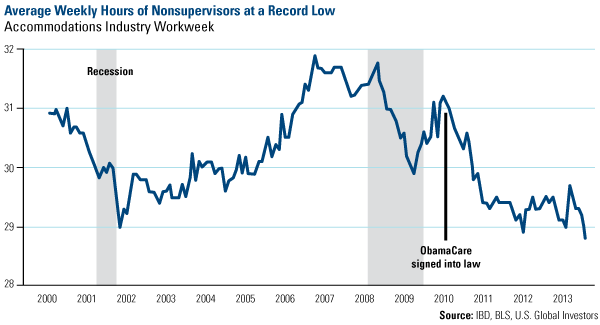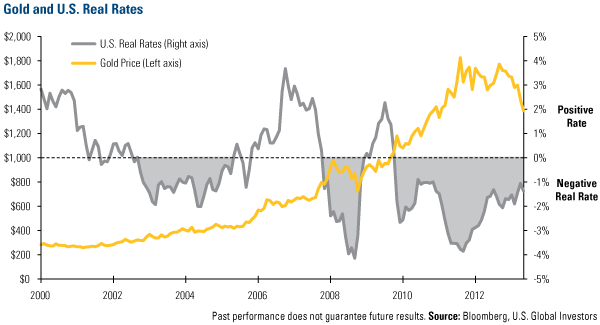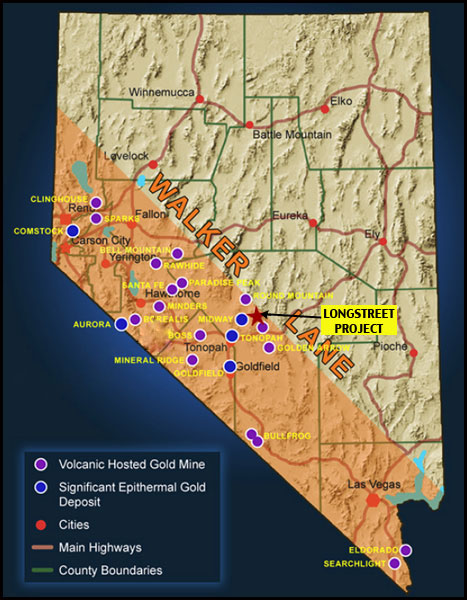The Gold Report: The Federal Reserve decided last week against tapering its quantitative easing. Gold rose $55/ounce ($55/oz)—over 4%—as a result, and silver was up 6.5%. Were you surprised by how robust this one-day rally was?
Michael Curran: Not really. We had already been out with our call in early July for a potential 25% recovery in the gold price in H2/13, which is the average fall recovery seen over the past four years. As such, we saw potential for gold to reclaim $1,450–$1,500/oz over the next few months, so we viewed the Fed tapering news as just another “quiver in the bow” to see our recovery scenario come to fruition.
TGR: Now that tapering is off the table, can we expect an end to the downward pressure on gold and silver?
MC: Our view is that with tapering off the table, short-term prospects for gold and silver are materially improved.
TGR: To what would you attribute gold’s spectacular fall earlier this year?
MC: I think it was a stock market malaise leading investors to liquidate gold to cover other losses.
TGR: We’ve been hearing about liquidation bringing down the price of gold for some time. Is there a point at which investors have done all the liquidating they need to do?
MC: That would be our view. In prior pullbacks in the gold price, we didn’t really see much liquidation in gold exchange-traded funds (ETFs). But this year, for the first time, we saw meaningful selloffs, and these investors redeployed their assets elsewhere. I think we’ve seen the bulk of that. August was the first net positive month for gold ETFs since the spring.
TGR: Small- and micro-cap explorers have suffered terribly in the last 18 months. Can we now expect a resurgence of these stocks?
MC: I think we’ve seen the bottom, but it’s the quality juniors that are going to be the beneficiaries. Not all boats will rise. Investors need to be more selective than in past recoveries.
“With tapering off the table, short-term prospects for gold and silver are materially improved.”
Our recommendation is to focus on early exploration or discovery plays. We’re also looking beyond gold. We like select base metals and uranium, and we have a few favorites there as well. Diversification is our focus for investors right now.
TGR: There are a great many low-price metal stocks today, but how do we find the real bargains?
MC: We concentrate on assets, location, management and balance sheets. We’re looking for assets with potential for high-grade discovery. We’re looking for low political risk in the location of these assets. We’re looking for strong management with backgrounds in exploration and discovery or people who have demonstrated past involvement in success stories. And we’re looking for companies that have enough cash to do exploration in the short term or a combination of assets and management expertise sufficient to raise money, which is not the easiest thing to do in this market.
TGR: Which speculative gold play do you find most attractive?
MC: Cayden Resources Inc. (CYD:TSX.V; CDKNF:NASDAQ) is currently our favorite speculative drill play. It has two main projects in Mexico, Morelos Sur in the Guerrero Gold Belt, which many investors will be familiar with, and the El Barqueño property in Jalisco.
TGR: Cayden is up about 50% in the last month to about $1.50 a share. Your 12-month price target is $3, which would be a 100% increase. On what do you base that projection?
MC: We’ve visited Cayden’s properties earlier this year. Morelos Sur is more of a long-term play. This is a blind, buried deposit several hundred meters below surface. It could take some time to discover a new skarn-hosted gold deposit, but certainly the market interest in the Guerrero Gold Belt is so strong that one good drill hole could generate a lot of interest.
“Investors need to be more selective than in past recoveries.”
Cayden’s neighbors in the area, Goldcorp Inc. (G:TSX; GG:NYSE), Torex Gold Resources Inc. (TXG:TSX) andNewstrike Capital Inc. (NES:TSX.V), have all had very good success on these kinds of targets and found multimillion-ounce deposits.
TGR: Goldcorp has found over 13 million ounces (13 Moz), Torex over 5 Moz and Newstrike over 2 Moz.
MC: That’s right. So Morelos Sur is the big potential discovery. El Barqueño has the lower short-term risk; as recent results have confirmed near-surface mineralization. Drilling will begin shortly and we expect the initial drill program can be successful and delineate resources. We see initial potential of 1–2 Moz at El Barqueño.
TGR: Hasn’t Cayden’s management had success in the past?
MC: A lot of the management team was with Keegan Resources, which was recently renamed Asanko Gold Inc. (AKG:TSX; AKG:NYSE.MKT). Your readers will know about Asanko’s 6 Moz Esaase gold deposit in Ghana.
TGR: What other companies would you like to mention?
MC: One company we like in the gold patch is Premier Gold Mines Ltd. (PG:TSX). The company has a very strong portfolio of assets with high-grade components in both Ontario and Nevada. It has made several additions in the last 18 months from former Agnico-Eagle Mines Ltd. (AEM:TSX; AEM:NYSE) management. This is a junior with the technical expertise of a mid-tier producer.
TGR: Premier Gold Mines shares rose 19% last Wednesday on results from two holes at its Cove Project in Nevada, including 6.74 grams per ton (6.74 g/t) gold over 9.1 meters and 26.3 g/t gold and 39.8 g/t silver over 2.3 meters. How significant are these results, in your opinion?
MC: We believe Premier Gold’s 19% rise was a result of two positive developments that day—the Cove project drill results reported before the open and the announcement by the Fed regarding tapering in the afternoon. We viewed the drill results as positive as the latter higher-grade intercept you mentioned successfully extended the Helen zone gold mineralization to the east of previous drilling. The other intercept you noted opens up the potential for the Helen zone mineralization to extend several hundred meters to the east, to below the previously mined Cove open pit. Of course, follow-up drilling will be required to confirm this.
TGR: Under a joint-venture agreement, Newmont Mining Corp. (NEM:NYSE) can buy 51% of Cove. How likely do you think that is, and do you think Premier is a possible takeover target?
MC: We believe that it is highly likely that Newmont will be involved with any mine development at Cove, either through the exercise of its right of first refusal or as the preferred partner to process Cove ores, thus holding either a direct interest or via a toll-processing agreement.
TGR: Goldrock Mines Corp. (GRM:TSX.V) was another winner last Wednesday, up 11% after announcing a $9.25 million ($9.25M) strategic alliance with Austral Gold Ltd. Goldrock’s stated objective is to develop its Lindero project in Argentina by 2015 so as to “become a mid-tier gold producer with annual gold production of 250,000 oz.” Does it now have the means to accomplish this?
MC: While we view the news of attracting a new strategic partner as positive for Goldrock, the company still has a long way to go to complete full financing for the development of its Lindero gold project in Salta, Argentina. Even with successful fundraising, the Lindero mine would only represent the first step toward achieving the company’s production target of 250,000 oz/year (250 Koz/year), as the open-pit, heap-leach mine is only forecast to be a 125 Koz/year mine. Thus we assume Goldrock’s target of becoming a 250 Koz/yr gold producer would require a second producing asset, likely via acquisition.
TGR: At its Coffee gold project in the Yukon, Kaminak Gold Corp. (KAM:TSX.V) has already drilled more than 35,000 meters this year and has announced a $2.5M bought-deal private placement so it can drill more. Is Kaminak looking to increase the size of its resource or its reliability or both?
MC: One of the main objectives of this summer’s $11M exploration budget was to delineate additional gold resources in proximity of the main mineralized zones at Coffee. We expect the expanded drill program will continue these efforts, as well as provide some infill drilling to increase the reliability (confidence) of gold resources in the main zones, presumably focusing on areas of higher-grade mineralization.
TGR: How many ounces could we see at Coffee?
MC: We believe drill results this summer could increase total resources at Coffee from the previous 3.2 Moz level to 3.7–4 Moz. Longer-term, we maintain our view that gold resources are likely to exceed 5 Moz.
TGR: Shares of Dalradian Resources Inc. (DNA:TSX) are up almost 50% over the last month. Its flagship project, Curraghinalt in Northern Ireland, has exceedingly high-grade gold, although most of its measured ounces (2.23 Moz out of 2.79 Moz) are Inferred. How close is Dalradian to derisking Curraghinalt?
“Our recommendation is to focus on early exploration or discovery plays.”
MC: We are awaiting a major milestone for Dalradian later this fall, when the company is expected to receive environmental permits that will allow the next phase of exploration at Curraghinalt to begin. This phase centers on 2 kilometers of underground development that will allow Dalradian to perform detailed infill drilling to confirm and upgrade the Inferred resources, as well as test mining methods and provide a bulk sample for metallurgical testwork, as part of feasibility-level economic studies. We expect this phase to begin early in 2014 and take 15–18 months to complete.
TGR: If the price of gold makes a substantial and sustained move toward $2,000/oz, will we see an end to the doom and the gloom and a return to excitement in the junior sphere?
MC: I think so. For some existing companies, it’s probably too late, but if we approach $1,800/oz, $1,900/oz and $2,000/oz, we’ll have a new wave of names coming up. We’d see new money going into new stories, as opposed to propping up existing exploration stories that haven’t worked.
TGR: Mike, thank you for your insights.
Michael Curran, CFA, is a managing director and a mining research analyst with Beacon Securities Ltd. in Toronto. He was previously a managing director and a mining research analyst with RBC Capital Markets. Curran received the #1 Ranking for Mining and Metals research coverage in The Wall Street Journal’s Annual Best on the Street Survey in May 2013. He holds a Master of Science degree in mineral exploration, a Master of Business Administration and is a CFA charterholder.
Want to read more Gold Report interviews like this? Sign up for our free e-newsletter, and you’ll learn when new articles have been published. To see a list of recent interviews with industry analysts and commentators, visit our Streetwise Interviews page.
Related Articles
- Look Beyond Gold for Compelling Risk/Reward Ratios: Michael Curran
- Sprott’s Charles Oliver Sees the Shine Returning to Metals
- Brent Cook: Do NI 43-101s Provide a False Sense of Security?
DISCLOSURE:
1) Kevin Michael Grace conducted this interview for The Gold Report and provides services to The Gold Report as an independent contractor. He or his family own shares of the following companies mentioned in this interview: None.
2) The following companies mentioned in the interview are sponsors of The Gold Report: Cayden Resources Inc., Goldcorp Inc. and Premier Gold Mines Ltd. Streetwise Reports does not accept stock in exchange for its services or as sponsorship payment.
3) Michael Curran: I or my family own shares of the following companies mentioned in this interview: None. I personally am or my family is paid by the following companies mentioned in this interview: None. A principal of Beacon Securities is on the Board of Directors for Cayden Resources Inc. I was not paid by Streetwise Reports for participating in this interview. Comments and opinions expressed are my own comments and opinions. I had the opportunity to review the interview for accuracy as of the date of the interview and am responsible for the content of the interview.
4) Interviews are edited for clarity. Streetwise Reports does not make editorial comments or change experts’ statements without their consent.
5) The interview does not constitute investment advice. Each reader is encouraged to consult with his or her individual financial professional and any action a reader takes as a result of information presented here is his or her own responsibility. By opening this page, each reader accepts and agrees to Streetwise Reports’ terms of use and full legal disclaimer.
6) From time to time, Streetwise Reports LLC and its directors, officers, employees or members of their families, as well as persons interviewed for articles and interviews on the site, may have a long or short position in securities mentioned and may make purchases and/or sales of those securities in the open market or otherwise.




 Walker Lane in Nevada, straddling the California border hosts some of the most prolific gold mines in the United States. The trend is where the North American Plate meets the Pacific Plate. More than 50 million ounces of gold have been produced from mines on the Walker Lane including the world famous Comstock Lode and the Round Mountain gold mine owned by Kinross and Barrick Gold. I visited three projects in the Walker Lane recently and I want to share with you what I learned.
Walker Lane in Nevada, straddling the California border hosts some of the most prolific gold mines in the United States. The trend is where the North American Plate meets the Pacific Plate. More than 50 million ounces of gold have been produced from mines on the Walker Lane including the world famous Comstock Lode and the Round Mountain gold mine owned by Kinross and Barrick Gold. I visited three projects in the Walker Lane recently and I want to share with you what I learned.










